How to water cacti at home, care features

Most flower lovers have a liking for cacti. These evergreens can be an interesting decoration for your home or office interior. They are unpretentious to care. How to water cacti at home and ensure favorable conditions?
Content:
- How to care for cacti
- Watering Basics
- Water quality requirements
- Water temperature
- Features of watering in different seasons
- Do I need to fertilize and when?
- Is it possible to provoke flowering?
How to care
Cacti have three periods, which alternately replace one another: flowering, dormancy and growth. They don't grow fast. If you decide to keep such a plant, you should find out in advance what parameters it needs.
Location
Different species have preferences for lighting. Those whose homeland is the desert (Echinopsis, Gymnocalycium) love a lot of light. It is better to place them on window sills.
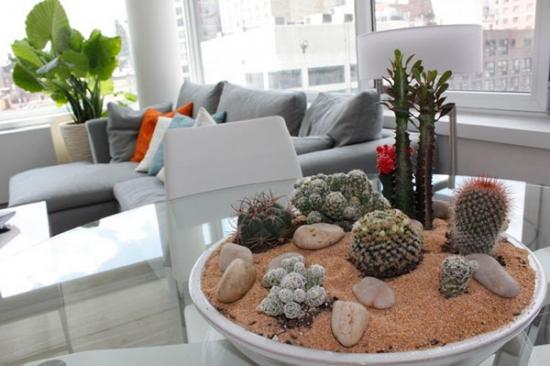
Representatives of forest flora (epiphyllum, zygocactus, Decembrist) are accustomed to darker areas. It is better to place them on windows on the east or north side. When there is too much light, life cycles are disrupted.
The soil
Each type of cactus has its own requirements for earth. All representatives of the species need soil that allows air and moisture to pass through well. The soil should not become compacted over time and remain loose. Most specimens like slightly acidic soil.
Capacity
Spiny plants should not grow in large containers. Pots are selected according to the size of the rhizome and aerial parts.
Temperature
Cacti are a type of plant that tolerates temperature changes well. Despite their love of warmth, they grow well in cool rooms. However, you should not place the pot near radiators, where the air is very dry.
All members of the species are adversely affected by frequent changes of location. There is no need to rotate the pot around its axis. If there are a large number of them, it is convenient to keep them on one stand or pallet.
Watering Basics
Cacti grow in unusual climatic conditions, so there are special requirements for their watering. This matter has its own subtleties, which are associated with the cyclical nature of the plant. Some specimens growing in the desert are capable of accumulating more than one thousand liters of water.

Watering can be done in two ways:
- Standard watering from a watering can with a thin spout or other container.
- Water is poured into the pan of the pot. Through the drainage holes, the soil will absorb as much moisture as necessary.
Floriculture experts say that there is not much difference in how to water a cactus. You can alternate between different methods or give preference to the one that is comfortable in a particular case.
Avoid getting water on the plant stem. Excess moisture causes more harm than lack of moisture. Be sure to ensure that water does not stagnate in the pan.
Water quality requirements
Almost all plants do not like hard water. In most regions, tap water is not of high quality. It is necessary to defend it.The best option would be to purchase a filter that removes chlorine well. For hard water, boiling is also allowed.
If you have access to distilled water, you can use it. However, this method may be too expensive.
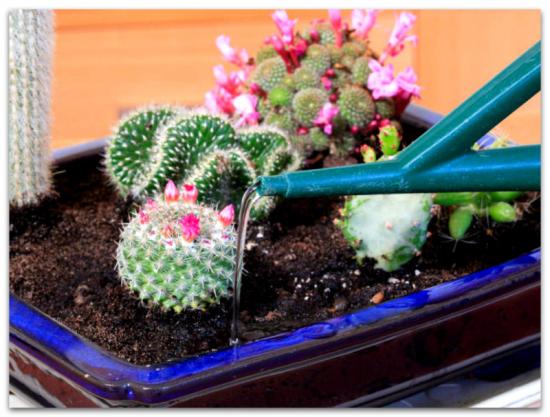
If possible, take melt or rain water. A good option for residents of private houses who have the opportunity to go outside at any time. This liquid is ideal for watering. Plants receive moisture with an identical composition under natural conditions.
Water temperature
The cactus will feel comfortable if the water temperature is suitable. For irrigation, it should be 5-7 C higher than the room temperature.
Other experts are of the opinion that the best option for watering is a liquid with a temperature of 30-40 C at any thermometer in the room.
For spraying you should take hotter water. It cools down quickly during irrigation. Cacti love this type of moisture. It is advisable to choose a fine spray nozzle.
To water plants with melt or rain water, it is advisable to pre-heat it in the sun.
Features of watering in different seasons
Cacti require different intensities glaze depending on the season. Parameters such as air temperature, humidity, lighting, soil type, and stage of the life cycle are taken into account. In natural habitats, environmental parameters also change depending on the time of year.
Winter
Flower growers are interested in how to water a cactus at home in winter. This period is characterized by lower temperatures. Watering is carried out moderately. In winter, you should not increase the intensity even if flowering.
You can check how moist the soil is with a pencil or wooden stick. Focus on how the soil looks and whether it is dry.
Spring

Plant growth intensifies from mid-spring. This means that more moisture is required. The frequency of watering should be increased from mid-April. Monitor the condition of the soil. Constantly keeping roots in water is harmful and risks rotting.
Summer
How to water cacti at home in the summer, and how to change care? During the hot period, the plant needs liquid more than ever. The intensity of watering in summer is greatest compared to other times of the year. To make the plant feel good, practice fine spraying. This method is safe, there is no risk of root rotting.
Autumn
In the autumn season, watering should be done in two stages. Until mid-October, the amount of watering should be maintained similar to the summer period. Then the frequency is reduced and minimized by the end of November.
For cacti, it is necessary to observe seasonal watering. The tone and well-being of the indoor plant depends on this. With the right approach, it will delight you with its excellent appearance.
Do I need to fertilize and when?
Cacti do not need frequent feeding. When choosing fertilizer, give preference to nitrogen-containing ones. Flower growers do not recommend purchasing fertilizers that have an organic composition for cacti.
It is easiest to apply fertilizers that have a liquid structure. The ideal option would be to purchase a ready-made product at a flower shop, designed specifically for cacti. It should be diluted with filtered or boiled water according to the instructions.
No need to overfeed fertilizers. Abuse of fertilizers is more harmful to the plant than lack of nutrition.
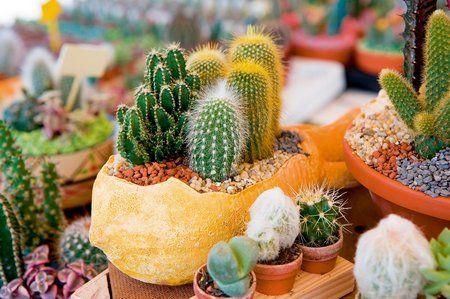
Types of fertilizers:
- Stimulating flowering. They contain calcium, nitrogen and phosphorus.
- For the rest period. For this purpose, minerals have a different ratio. Take 2 times less phosphorus.
Fertilizer mixtures should be carefully diluted. There is no need to try to give the plant an overly concentrated liquid.
Is it possible to provoke flowering?
This is a plant that rarely pleases with its flowering. It is not always possible to push him towards this process. The first thing to do is to maintain all the necessary living conditions (light, watering, humidity). Some gardeners add special fertilizers to the soil.
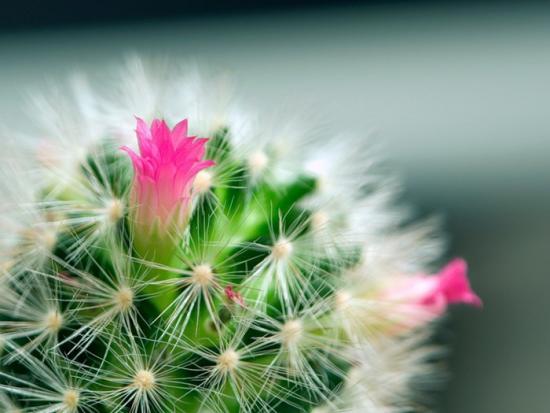
You can install a drainage tube in the soil. Inject water into it using a syringe without a needle. At the same time, do not forget to control the degree of moisture.
It is worth remembering that the cactus will not bloom until it reaches a certain age. In addition, a flowering cycle must begin after dormancy.
Cacti are extraordinary plants that do not require complicated care. It is enough to remember the simple rules of maintenance and watering. Under good conditions, the cactus will not only look great, but will also delight the owner with flowering.
Now let's see how to water cacti at home in the video:


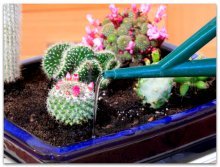











Comments
I water my cacti twice a week with water passed through a regular Barrier filter, and when they begin to bloom, I water them with mineral water, which I take from a real spring.
We water the cacti with water that has stood for at least two days. They grow very slowly and bloom periodically - it’s very beautiful. Some bloom for one day, others for a week.
I water cacti with regular tap water. They grow beautifully, they even bloomed a couple of times in 5 years. I didn’t think that these prickly ones have such a problem with watering)) I’ll take some advice into account.
I water cacti, like other indoor plants, only with purified water. Previously, I watered it with settled tap water, but salt deposits appeared on the soil and pot. I water the cacti as the soil dries out; you can’t overwater them, but “over-drying” is also harmful, as this can cause them to dry out. In winter and early spring, I reduce watering to once every 7-10 days.